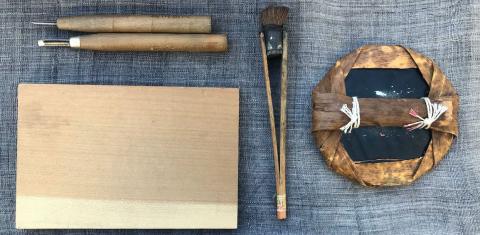
The Process of Woodblock Printing

During the Edo period (1603-1868), as the mass production of woodblock prints flourished in Japan, the process was largely a team effort, involving four primary contributors: the publisher, artist, carver and printer.
The publisher led the project, commissioning an artist to create the design. The artist executed a line drawing on paper, making notes about color and other details, and gave the design to a carver, who in turn applied the paper facedown to a block of cherry wood. Using chisels and knives, he carved away all the white areas, leaving only the lines of the artist’s design in the block. For full-color printing, developed in the late 18th century, the carver carved separate additional blocks for each color. Finally, a printer applied different colored inks to each block, placed a sheet of print paper on the surface of the blocks and then rubbed the back of sheet with a rubbing pad called a baren to transfer the design. Color by color, the artist’s design was transferred onto the paper. Each color block was also carved with registration marks to allow the printer to align all the colors in the final design on a single sheet of paper.
Once blocks were carved, they could be used to produce hundreds of copies of the same design, making illustrated books and prints by famous artists accessible to the general public at a low price – the cost of a bowl of noodles. It is important to note that, although these prints include the printed signature of artists like Hokusai and Hiroshige and are attributed to them, these artists did not actually create the final prints – just the original design. In many cases, the names of the publisher, block carver, and less often the printer, can be found in the margins of the prints.
Woodblock for a Print Designed by Tsukioka Kōgyo (1869-1927)

Tsukioka Kōgyo was a print designer of the late 19th and early 20th centuries and is best known for his scenes from Noh plays. This print depicts three actors performing in a yet-unidentified scene. The carver’s chisel marks outside the main image and the registration marks, or kentō, that helped the carver align each color block, are visible along the frame of the design.
Stages of Full-Color Printing Process
This set of prints replicates an image designed by Hiroshige in 1853. They were printed in the 20th century to demonstrate the process of layering colors to create a full-color woodblock print. In the 19th century, the average full-color print had ten colors with a black outline carved into the key block. To create the colors and sense of depth in this image, the printer starts with the paler background colors and then adds the brightly colored details later. The final block featuring sharp black diagonal slashes adds rain to the scene.
Related Programs
February
・Curator’s Talk | Nature/Supernature Exhibition
March
・Film Screening | A Letter to Momo
・Webinar Conversation | Yōkai Past and Present
April
・Webinar | Scenic Views and Supernatural Beings: New Themes in 19th-century Ukiyo-e Prints
May
・Webinar | Woodblock-printed and Real Journeys Through Japan
Explore More of the Exhibition
Main Exhibition Page

*Note: Japanese names in this exhibition are written in the traditional Japanese order, with the family name first and personal name last. However, if an artist has come to be known by a single name, (e.g., Hokusai and Kunisada) that name will be used for subsequent mentions.

